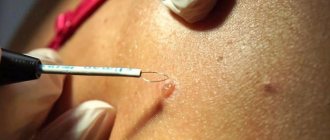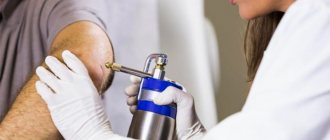From this article you will learn:
- When is laser removal of papillomas necessary?
- What are the advantages of the laser method for removing papillomas?
- How is the procedure for removing papillomas using a laser performed?
- What are the consequences of laser removal of papillomas and how to cope with them
- What is better than laser removal of papillomas?
Papillomas, moles, warts and other benign formations appear on the body and face at any age. Their presence confuses a person and causes significant inconvenience. Although they are harmless to health, since they are located on the skin, they look extremely unaesthetic. In addition, in most cases they can be located in inconvenient places, where they can easily be touched and injured, and therefore cause pain and discomfort. Laser removal of papillomas is today considered one of the most effective ways to get rid of skin tumors.
When is laser removal of papillomas necessary?
Papillomas
- These are neoplasms that appear due to a viral infection. Most often it affects people with weak immune systems. This virus is called papillomavirus. The main areas it affects are the skin and mucous membranes.
A person may not even suspect that the papillomavirus has settled in his body. New growths do not appear on the skin immediately. The virus can spread for quite a long time without any symptoms, and then appear on the body in the form of papillomas. They come in different sizes (from a millimeter to several centimeters) and shades (from flesh to dark brown). They are easy to recognize: imagine a wart on a stalk.
Papillomas are often found
on the face around the eyelids and inside the nose, on the neck, in the ears, armpits, in the genital area (on the labia and cervix), in the larynx and oral cavity.
Human papillomavirus
(HPV) can be dangerous.
If it spreads to human genitals, there is a possibility of it degenerating into malignant tumors. Like any virus, HPV enters the body from the outside. This happens during sexual intercourse
. It is introduced into the body through epithelial basal cells, in which its active reproduction occurs.
It can also be transmitted through household means.
This happens less often, but still such a possibility cannot be excluded. Infection can be acquired in a swimming pool or public bath, or when using other people's household items and personal hygiene items. When kissing, HPV is transmitted through the lips and begins to parasitize the oral mucosa.
During childbirth or pregnancy from mother to child
vertical mode of infection occurs.
There is evidence of infection of medical personnel who operated on tumors through surgery. This means that the virus can spread through airborne droplets.
Prerequisites for the manifestation of symptoms are:
- Weakening of the immune system as a result of an infectious disease;
- Smoking;
- Alcoholism;
- The presence of urogenital infections (mycoplasmosis, herpes simplex, ureaplasmosis, chlamydia);
- Stress;
- Long-term use of contraceptives;
- Lack of vitamins (particularly vitamin A).
The risk of acquiring HPV through sexual contact is extremely high. Because more than half of people who have reached puberty are carriers of this type of virus.
Let's look at some reasons for laser removal of papillomas
:
- Aesthetic discomfort;
- Functional disorders of the organ on which the papilloma has formed (the neoplasm can grow into surrounding tissues);
- The risk of papilloma degenerating into a malignant tumor.
There are 130 different types of papillomas. Ten of them are capable of developing into a malignant form. This happens mainly when papillomas are exposed to external processes. Constant rubbing with clothes, scratching, and touching the tumor during depilation lead to damage, which subsequently causes their transformation into malignant forms.
Recommended articles on the topic:
- Painless lip modeling: techniques and recommendations
- Beauty injections: types, preparations, reviews
- Eyelash restoration at home and in a beauty salon
There are two types of indications
to laser removal of warts and papillomas:
aesthetic and medical.
The aesthetic reason is the desire to eliminate external defects when papilloma is localized in open areas of the body.
Medical indications
for laser removal of papillomas:
- Frequent tumor damage;
- Unpleasant sensations, pain, itching, burning in the areas of growth;
- Changes in the color, size, shape of the tumor;
- Increased number of papillomas;
- Threat of malignant degeneration (determined by appropriate tests).
Diagnostics
If papillomas form on the body, face or genitals, you should consult a dermatologist. This will allow not only to diagnose human papillomavirus infection at an early stage, but also to take measures to prevent the formation of new elements, as well as monitor changes in existing ones.
It is especially important not to delay visiting a doctor if there are signs of growth, change in color of the papilloma, unpleasant odor or pain in the area where it is located.
First of all, the doctor will perform a dermatoscopy, i.e., an examination of the tumors using a special magnifying device. This will make it possible to determine their nature, as well as to notice dangerous signs indicating a high probability of degeneration of a benign tumor into a malignant one, not to mention the formation of a cancerous tumor. When detected at an early stage of development, they can be successfully treated and have a favorable prognosis in the future.
Patients are recommended to be tested for the presence of STDs, especially if condylomas are detected in the genital area. Also in such situations, women are advised to consult a gynecologist, and men - a urologist. This is important for diagnosing the presence of human papillomavirus infection of the cervix, urethra, etc. and, if necessary, prescribing appropriate treatment.
To confirm papillomatous infection, patients are usually prescribed a PCR test. With its help, it is possible not only to confirm or refute infection with the human papillomavirus, but also to accurately determine the strains.
Types of growths for which the laser method of removing papillomas is used
Let's look at the main types of papillomas.
- Simple
- hard nodules covered by keratinized skin. They can appear close to each other and merge into one large formation.
- Flat
- look like moles.
- Thread-like –
bump-like growths resembling a mole. Subsequently, they spread and turn into papillary-like formations up to 6 mm in size. Appear on the skin in the eye area, neck, armpits.
- Plantar –
cones with a smooth surface, surrounded by a rim.
- Genital
warts
are growths that appear on the mucous membranes of the genital organs. This species is spread through sexual contact. - Epithelial
hyperplasia
is a small growth that affects the lips and mouth. They can merge with each other. - Juvenile
laryngeal
papillomas - they are found in the larynx of newborn children. Infection occurs from the mother when passing through the birth canal.
Read material on the topic: Lightening age spots
Laser removal of papillomas and other methods of elimination
It is recommended to begin treatment for HPV immediately after an accurate diagnosis and consultation with a doctor. It is necessary to fight the virus in full. An integrated approach includes the selection of the correct therapy to eradicate the causes of the disease and laser or any other removal of papillomas from the human body.
There are several variations of methods for eliminating growths. All of them are painless, safe and will not leave scars.
Medical removal of papillomas (cauterization)
This is removal with the help of drugs -
such as natural compounds feresol or verrucacid containing phenol and metacresol. These drugs are used to cauterize papilloma. This procedure must be performed with extreme precision and caution. You can't do it yourself. Carelessness and lack of experience often lead to burns.
Laser removal of papillomas
Laser removal of papillomas and condylomas involves a burning process using a carbon dioxide laser beam
. The laser hits exactly the right place and does not damage the surrounding skin. As a result of removal, a microscopic wound is left that heals in three to four weeks. The skin heals itself, so additional restorative procedures are not necessary. Scars will not appear. Laser removal of warts and papillomas is not recommended if there are wounds or any inflammation on the skin, herpes or other infection. This procedure is also not performed during pregnancy. Laser removal of papillomas located on the face, eyelids, and armpits is carried out if both single and multiple neoplasms are detected.
Removal of papillomas with liquid nitrogen (cryodestruction)
The method involves short-term exposure of the papilloma to very low temperatures.
. The damaged area of skin is treated with liquid nitrogen, after which it loses sensitivity and becomes white. Freezing occurs immediately, as a result of which the papilloma is destroyed. Tissue healing may take five to six weeks. There will be no scars left. This procedure has a number of advantages. It is well tolerated by humans, painless and does not require pain relief.
Radio wave removal of papillomas
Radio wave removal is the optimal solution for skin problems. It occurs using the Surgitron device. The neoplasm is destroyed due to energy that heats the papilloma from the inside without damaging surrounding tissues
. The electrode, which is the main working part of the device, heats up, and the papilloma is immediately “cut off” with one movement. In this case, there is no loss of blood due to the fact that the tissues are cauterized and remain unharmed, and the vessels are “sealed”. The procedure does not cause pain. After it, the wound heals quickly and no traces of papilloma removal remain.
Electrocoagulation
With electrocoagulation, the destruction of pathological tissue is achieved by exposing it to electric current.
using EHF devices. High temperature affects the papillomas, and they are destroyed. The advantage of this procedure is the ability to control the depth of exposure, as well as its low cost. But there are several disadvantages. Nearby tissues and skin areas may be subject to injury. Healing after this method occurs over a long period.
Surgical removal with a scalpel
Surgical removal is used in cases of removal of large tumors
. The operation is performed under local anesthesia. Since after removal, cosmetic stitches are applied to the skin for seven days, this method is used extremely rarely if the papillomas are on the face. But it is effective in the fight against malignant growths.
ethnoscience
Traditional medicine has always helped to get rid of any misfortune. To remove papillomas, the method of treating them with celandine juice
.
This plant has poisonous juice, therefore, in order not to damage neighboring areas, baby cream is applied to them. A drop of celandine juice is squeezed onto the neoplasm itself. The next option is an infusion of dandelions in alcohol
, which is applied to the area of the growth five times a day.
The infusion is prepared in the following way. The heads of dandelion flowers are placed in a glass jar and filled with ethyl alcohol. It should be kept in a dark room for two weeks. And then use it for treatment. It is difficult to say how safe and effective all of these methods are, so it is better not to tempt fate and consult a doctor
.
Read material on the topic: Dermatological facial cleansing: types, reviews and prices
Do vestibular papillomatosis need to be treated and how can it be cured?
Since this condition is not considered a disease, is not contagious and does not degenerate into cancer, it is not subject to mandatory treatment. However, many women decide to remove such “papillae”. Removal of benign papillomas is also indicated if they cause irritation, inflammatory processes, interfere with intimate life, or become a source of psychological complexes.
Micropapillae are removed by cryodestruction - treatment with liquid nitrogen. A laser or radio wave method is used, after which no traces are left on the mucous membranes. Vestibular papillomatosis no longer appears after treatment.
This condition is not contagious, so if micropapillae are detected in a woman, her partner does not need to undergo any tests. His health is not in danger. Strange “papillae” that appear in a man should be a reason to consult a doctor, since they are caused by some other disease.
Why is laser removal of papillomas so in demand?
Before the use of laser removal of papillomas in medicine, warts were cut off using electrical methods, the use of chemical reagents and low-temperature nitrogen. Laser removal of papillomas is an innovative technique that provides painless removal of the tumor.
Thanks to low intensity radiation, blood circulation in the body is stimulated and healing is accelerated. Along with removing the growth, the laser beam seals the blood vessels, eliminating the occurrence of inflammation and scars.
Laser removal of papillomas on the face is an extremely precise procedure
. There is disinfection of the wound and absolute control over the depth of penetration, in which the tissues around the affected area are not exposed.
Which laser device is used to remove papillomas?
The following types of lasers are used in dermatovenerology:
Lasers with constant radiation (conventional)
This type of laser is used to remove warts, papillomas, and genital warts. It has powerful, highly focused constant radiation, which quickly leads to the evaporation of pathological papilloma cells.
The main disadvantage is the scars left behind. Therefore, this type is not suitable for facial surgery. If the papilloma or wart was large, then the mark after removal will be rather large.
Pulsed lasers, or fractional lasers, or resurfacing lasers
They can be used to remove unwanted formations in the facial area, such as small papillomas, flat warts, senile keratomas and age spots, as well as for skin peeling.
The laser acts in a pulsed manner, so there is no burn on the skin. This device only removes the surface layer. After the procedure there are no traces or scars left.
Where to undergo destruction of genital warts (papillomas) in Moscow?
In a multidisciplinary medical center you can always perform the destruction of genital warts (papillomas)
. Our medical center is located between the Konkovo and Belyaevo metro stations (South-Western Administrative District of Moscow in the area of the Belyaevo, Konkovo, Teply Stan, Chertanovo, Yasenevo, Sevastopolskaya, New Cheryomushki metro stations " and "Trade Union"). Here you will find highly qualified personnel and the most modern diagnostic equipment. Our clients will be pleasantly surprised by our quite affordable prices.
In what cases should laser removal of papillomas not be used?
Contraindications
for laser removal of warts and papillomas are:
- Herpes in the acute stage;
- Diabetes;
- Pregnancy and lactation;
- Epilepsy;
- Immunodeficiency conditions;
- Malignant nature of neoplasms;
- Any diseases of the skin and blood;
- Tan obtained 2 weeks (or less) before the procedure.
What are the advantages and disadvantages of the laser method for removing papillomas?
How does laser removal of papillomas work? First, the beam affects the tumor, resulting in the destruction of infected tissue. The place where the papilloma was located is covered with a crust to protect the healing process from the external environment. It will occur in a short period due to the disinfecting effect that the hardware technique has.
Some do not risk using the services of this procedure, not suspecting that the laser is used even in gynecology due to its accuracy and control of the effects. It is used to treat condylomas that have formed on the genitals.
From all of the above, we can conclude that the main advantages
Laser removal includes:
- No burnt tissue;
- Prevention of the inflammatory process;
- The ability to remove hundreds of small tumors (up to 1 cm in size) in one treatment session.
But there are also disadvantages.
When using a laser beam, side effects such as burns are possible.
The postoperative period passes quickly. During this time, redness may appear in the treated areas, followed by the formation of a scab. But this is a normal phenomenon after a laser procedure.
You should seek the help of doctors if swelling and hyperemia appear after laser removal of papillomas or warts. This can happen if the body has a tendency to allergic reactions to the sun.
Blisters may form on sensitive skin. After self-healing, their place is taken by barely noticeable whitish scars.
Read material on the topic: Removing moles on the face without pain and consequences
Pedicled papilloma: diagnosis, histology
Pedicled papillomas, like other papillomas, must be subjected to histological examination.
This will complement the cytological examination.
The histological examination method consists of analyzing a biopsy specimen - a part of the papilloma obtained during its removal.
A microscope is used for this.
We evaluate the nature of the benign tumor and determine the degree of oncogenicity of the papilloma.
Within three days after the study, we have the result.
The diagnosis of papillomatosis when infected with HPV occurs on the basis of laboratory diagnostics:
- cytological analysis (to determine changes in the cellular material of the test sample);
- carrying out a polymerase chain reaction (to find viral DNA in the material under study);
- obtaining a biopsy specimen for histological examination;
- carrying out the histological examination itself;
- conducting a daijin test.
The Daijin test is carried out to determine the type of HPV, its quantity and degree of oncogenicity.
Without laboratory research methods, based only on the clinical picture, even an experienced doctor has difficulty in making a correct and accurate diagnosis.
What are the stages of laser removal of papillomas?
Preparations for the laser removal procedure for papillomas must be taken with full responsibility. You should not sunbathe or go to a solarium at least two weeks before surgery. It is also better not to use household chemicals, go on a hypoallergenic diet and lead a healthy lifestyle. All this will help the skin cope with the procedure and survive the recovery process.
If papillomas are detected anywhere in the body, you must contact a specialist to find out the cause of the infection. Immunodeficiency is quite often the first sign of the appearance of tumors on the skin. Treatment begins after a conversation with a dermatologist and cosmetologist.
Since papillomas cells consist of 75 percent water, the laser action is based on the evaporation of liquid and the destruction of pathological cells. The fabric is cut off layer by layer until the growth is completely removed. Healthy areas near the tumor are not affected and remain unharmed.
Laser removal lasts no more than five minutes and occurs in the outpatient room. Let us consider in order what stages are performed during the procedure.
Stage 1.
The doctor
treats the skin with an antiseptic
.
Stage 2.
The doctor
administers pain relief
by injecting the patient with a syringe or applying a cream containing an anesthetic such as novocaine or lidocaine to the skin.
Stage 3.
The
pain relief will take effect
in three to five minutes. We must wait for this time.
Stage 4.
Everyone in the room wears
safety glasses
to prevent the laser beam from burning the retina.
Stage 5.
The doctor takes a laser and
treats the papilloma
around the entire perimeter. The burn remaining after removal is treated with fucorcin or any other antiseptic. It is better to apply a dry gauze pad and a bandage.
During the entire procedure, the patient has no pain at all
. The recovery period for healing of the skin or mucous membrane takes from six to eight days.
Does the laser method of removing papillomas have consequences?
Any external intervention in the human body will have negative consequences.
. Laser removal of papillomas is no exception, despite the fact that this procedure is quite useful. The consequences may be the following:
- In the place where the papilloma was located, a scar may appear
. This occurs in people whose tissue repair processes are slow.
- With improper care inflammation may begin
. After removing the tumor, it is necessary to observe measures to prevent wound suppuration, which is an important part of the entire procedure.
- For a short period after surgery possible weeping wounds on the face
. They should not be touched, much less covered with foundation or any other cosmetics.
During the procedure, the tumor is cut off with a thin laser beam. The process may take several minutes. It all depends on the size and location of papilloma formation. Complete disappearance does not occur immediately after surgery. It will take some more time for all traces to become invisible. This takes a week or even two weeks.
Side effects
in most cases, they appear after the use of local anesthesia, and not due to the operation itself. Patients may experience the following symptoms:
- Dizziness, sudden changes in pressure;
- Drowsiness, fatigue, lack of appetite;
- Peeling of the skin at the site of wart removal.
Complications may occur in some cases after laser removal of papillomas.
.
- In case of photodermatosis, a person may develop pigment spots after the procedure.
- In the presence of any allergic reactions, hyperemia or swelling may occur.
- For thyroid disease – keloid scar.
- For sensitive skin – slight burn redness with scab formation.
What to do after laser removal of papillomas
The main thing to do after the procedure is to follow the rules for caring for damaged areas. This is absolutely necessary if you want to achieve the best possible result. Under no circumstances should alcohol or similar products be applied to the wound. If the papilloma was removed in areas of a gynecological nature, then proper care is to use baby soap when washing.
Wound care after laser wart removal:
- Do not get wet for 24 hours, do not swim. The next day a crust will begin to form.
- Do not remove the crust.
- Do not apply any creams or ointments.
- Don't sunbathe.
- Do not take a steam bath or swim in the pool.
- Do not wear cosmetics.
- You can lubricate it once a day with fucorcin or potassium permanganate.
- You can put a gauze napkin on the wound, and an adhesive plaster on top, crosswise.
- You can wash your hands (if there is a wound on your hand), but you cannot soak the scab for a long time.
- After 2-3 weeks the crust will come off on its own. And in its place there will be healthy skin.
Complications of papillomas
The most important complication is the degeneration of benign neoplasms into malignant tumors.
It is necessary to determine as quickly as possible the type of HPV that caused the formation of papillomas.
If it is a highly oncogenic type 16 or 18, constantly monitor the development and changes in the condition of papillomas.
These pedunculated papillomas also threaten traumatization and relapse.
You should always remember this and avoid injury, and after removing papillomas, prevent their occurrence.
How much does laser removal of papillomas cost?
Price
laser wart removal costs from 500 to 2500 rubles.
The procedure
for removing papillomas is carried out both in private medical institutions and in public hospitals. The price will vary depending on the location of the operation, the qualifications of the specialists and the general performance of the clinic. The price for laser removal of papillomas may increase subject to additional tests that must be taken from the patient before the procedure.
Read material on the topic: Laser facial skin rejuvenation: useful tips and recommendations
What are flat papillomas?
Flat papilloma is quite easy to recognize by its external signs. The boundaries of papillomas can be either regular or uneven. As for the color of the formations, they can blend in with the underlying skin or be a little lighter. Papillomas rise slightly above the skin, but have a flat top.
If you have red dots on your body like moles, and you don’t know what it is, you can look at the article.
What to do so that laser removal of papillomas is not needed
In the modern world, medicine has advanced greatly. There are many preventive measures
and combating harmful viruses.
Even special vaccines
that are widely used in many countries.
Basic safety rules will protect you from meeting with the doctor and with HPV itself. It reproduces in places of high humidity. Therefore, you should not stay there for a long time if you want to avoid getting the virus into your body. It is extremely important to promptly treat abrasions and scratches.
to prevent infection from spreading in the wound.
As mentioned above, HPV is transmitted through sexual contact. Infection can be avoided by using barrier methods of contraception. also refrain from casual relationships
.
Everyone knows that by leading a healthy lifestyle, eating right and constantly strengthening the immune system, a person will remain immune to any type of infection, including HPV. The absence of nervous breakdowns and stress also significantly helps in the fight against viruses.
Remember, we said that HPV can settle in the body and not show any signs or detect itself. So, as part of prevention, you should undergo regular examinations
and take tests in order to detect it in time and take all measures to eliminate it painlessly and without consequences.
How do human papillomaviruses cause cancer?
Viruses are very strange creatures that are very different from cellular life forms. Currently, scientists have not fully decided whether these infectious agents can even be considered alive. Essentially, a virus is genetic material surrounded by a protein shell. It cannot reproduce on its own - for this it needs a cell of some organism, which, after infection, turns into a factory for the production of new viral particles.
Penetrating into a cell, HPV disrupts its internal regulatory processes. And this can lead to malignant degeneration. We talked about one of the studies, during which scientists tried to understand the mechanisms of this transformation, on the Euroonko website in 2022.
oncoprotein, a protein encoded by the viral E6 gene , plays a key role in the development of HPV-associated cancers It disrupts the functioning of the p53 protein in human cells - this compound is often called the "guardian of the genome" because it prevents normal cells from turning cancerous. As a result of this disorder, the enzyme telomerase is activated.
At the ends of chromosomes in human cells there are special sections - telomeres . Normally, they should shorten after each cell division. When the length of telomeres decreases to a critical threshold, the cell stops dividing and dies - this is a natural process. The enzyme telomerase lengthens telomeres, and thus its activation makes the cell “immortal.”
In addition, the viral E6 gene affects the function of the myc protein, which is involved in the regulation of cell division and programmed cell death - apoptosis . The result is also the activation of telomerase.
It is very important to study these mechanisms, because knowledge about them may help create effective methods for treating human papillomavirus infection and preventing the development of cancer.
Normally, the immune system recognizes cells infected with the virus and destroys them. If this does not happen, then the infected cells continue to multiply, and over time, precancerous changes appear, and then a malignant tumor.










